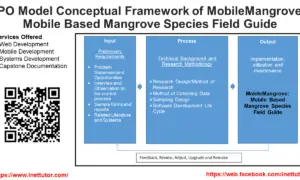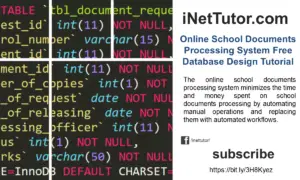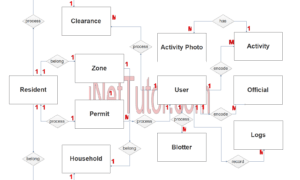Church Event Management System Conceptual Framework
This post presents the Conceptual Framework of the Church Event Management System which is based on IPO model.
About the Project
Table of Contents
Church organizations hold events to assist churchgoers in creating opportunities for camaraderie and growth. Church activities are frequently attended by a large number of individuals from the church, which necessitates a lot of effort for the appointed committee, from planning to registration. Without an effective system for event organization, the organizer may have a tough time handling all components of the event in a harmonious manner. The traditional approach of administering church activities may confront physical obstacles and time limits in completing the necessary preparations.
“Church Event Management System”, is a system that will allow church groups to automate the process of establishing and administering church events. The aforementioned project makes it simple for churches to book events and handle crucial event information.
Objectives of the Study
- To create a system that will allow church organizations to electronically alert church members about future events.
- The technology will allow event participants to register online.
- The system will provide a communication platform for the events committee to share preparation updates.
- To create a system that would make church event management easier.
- The system will be efficient and dependable.
Readers are also interested in: Church Event Management System
Conceptual Framework/Model
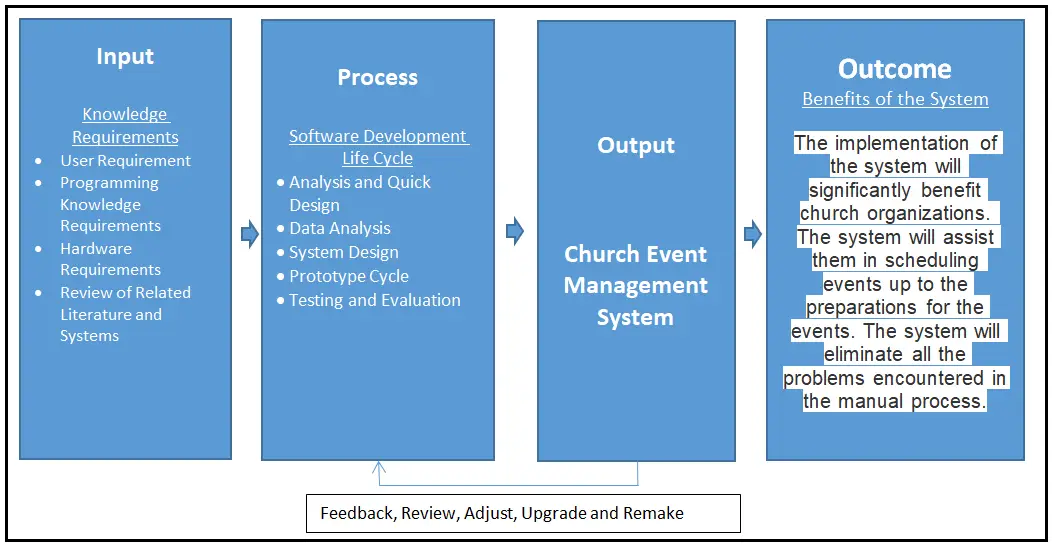
The image above is the conceptual framework of the project entitled Church Event Management System. It is based on IPO model or also known as the input, process and output model.
What is a Conceptual Framework?
A conceptual framework is a system of concepts, values, and principles that guides research. It helps researchers to clarify their goals and objectives, and to identify the assumptions on which their work is based. A conceptual framework can be used in a variety of ways, depending on the type of research being undertaken. For example, it can be used to help researchers define the problem they are trying to solve, to develop hypotheses about the cause or effect of a problem, or to identify key factors that influence a particular outcome.
A conceptual framework can also be used to guide research methodology. For example, it can help researchers design survey instruments, analyze data, and write reports. In addition, a conceptual framework can help researchers to think about research in a broader context, and to identify problems that may not have been noticed before.
Input
The input phase or the knowledge requirement stage consists of the following:
- User Requirement – The researchers conducted interviews with church groups to discover their needs so that the team could create an acceptable solution to address their current difficulties.
- Programming Knowledge – After establishing the difficulties, a solution must be offered in the form of an information system written in the programming language in which the researchers have enough knowledge.
- Hardware Requirements – Without hardware, such as a computer or mobile device, the system cannot function. The researchers had informed the churches that they required the gear in order to effectively employ the farm management system.
- Related Literature and Systems – the researchers performed research on various literatures and related systems to serve as guidance in the development process.
Process
Analysis and Quick Design
During Analysis and Quick Design, the researchers did a personal interview with the respondents and the chosen client where the study was conducted. The respondents were given the chance to suggest how the system will be designed. After conducting the data gathering, the researchers made an initial design for the proposed system.
The next step in developing a Church Event Management System is to identify the various stakeholders who will be involved in the project. These stakeholders can be divided into two groups: those who will be using the system and those who will be developing the system. The users of the system will include the church staff, the church volunteers, and the church members. The developers of the system will include the church staff, the church volunteers, and the technical experts.
Data Analysis
The researchers will analyze all the data, user requirements and information. This phase also help the researchers to have an idea on how to create the system and have an idea on how the proposed system would be beneficial to the clients.
The data analysis phase of a Church Event Management System is critical in ensuring the successful implementation of the system. This phase involves the identification and analysis of the data that will be used to support the system. This data includes event data, church member data, and financial data. The data analysis phase also involves the development of reports and dashboards that will provide information that is useful for decision making.
The key points that need to be considered during the data analysis phase of a Church Event Management System include the following:
- Identification of the data sources that will be used to support the system.
- Evaluation of the data sources to determine which are most reliable and accurate.
- Collection and analysis of event data.
- Collection and analysis of church member data.
- Collection and analysis of financial data.
- Development of reports and dashboards that provide information that is useful for decision making.
- Maintenance of the system data sources over time to ensure accuracy and reliability.
System Design
The researchers will start to develop the proposed system. It includes the design; how the system would look like based on user requirements, and the researchers/programmer would like to add personal design to make the system more interactive and user friendly.
Prototype Cycle
This stage will include the compiling, building, demonstration also refinement of the data gathered by the researchers. The researchers first build a prototype based on the planed design and data tables. After building the prototype it will be demonstrated to the client. The researchers show the function of the system, the flow on how it works, and the functions of the features that are included in the system. The last stage is refinement where in the researchers will refine the system by client’s additional needs. This will include changes in features flow and functions based on the requirements.
Testing and Evaluation
This will include the feed backing of the proposed system after it will be implemented and had undergone testing by three Experts. It will also inform the researchers and the developer if there are any bugs, suggestion and if the system’s functionality will works well.
The testing and evaluation phase of the Church Event Management System was conducted in order to ensure that the system functioned properly and was able to meet the needs of the church. A variety of tests were conducted, both functional and non-functional, in order to assess the system.
Functional tests were conducted in order to ensure that the system was able to handle the various tasks that are typically associated with an event management system. These tests included creating and managing events, tracking attendees, and sending out notifications.
Non-functional tests were also conducted in order to assess the overall design and functionality of the system. These tests included assessing user interface design, data entry accuracy, and system security.
This will discuss the implementation of the propose system wherein Three (3) Experts will evaluate the propose system. This will also discuss if the recommended functions and suggestion are met.
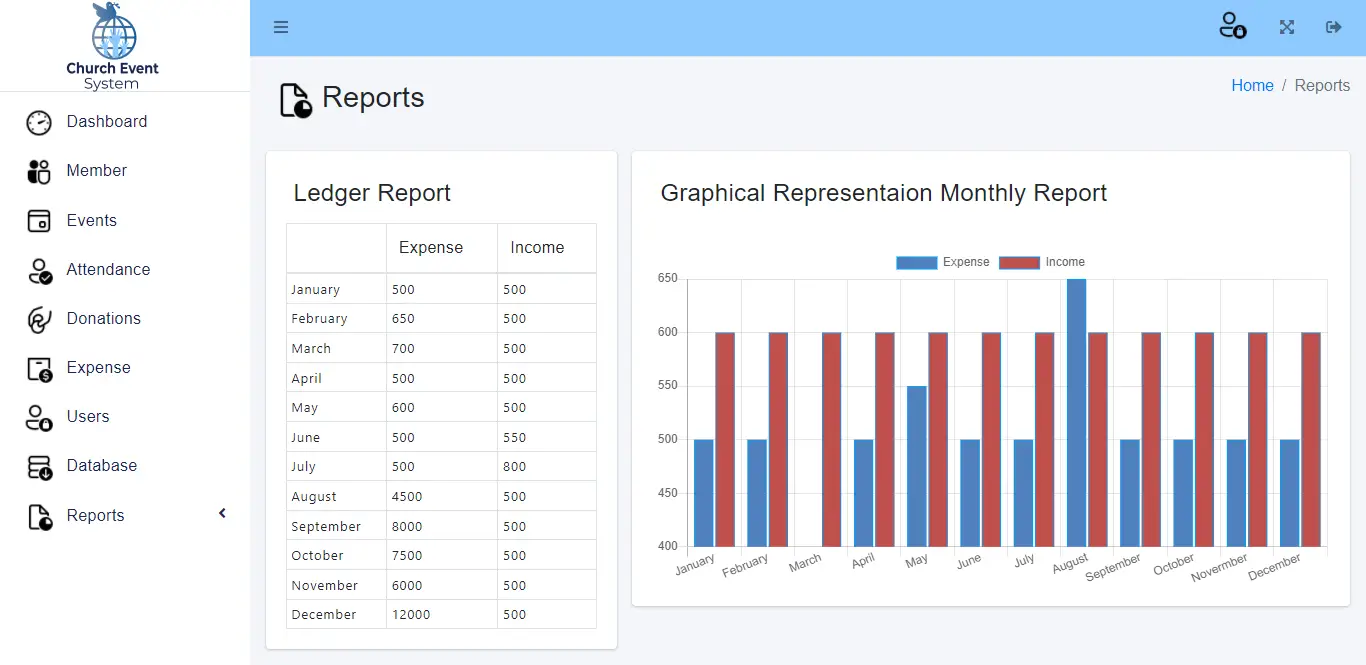
Output
The study’s ultimate outcome is a database-driven information system that will allow church groups to automate the process of establishing and administering church events. The aforementioned project makes it simple for churches to book events and handle crucial event information.
A church event management system is a set of tools and processes that helps a church to plan, organize, and execute events. It can be used for a wide variety of events, from small meetings to large conferences. The system can help to streamline the event planning process, and make it easier to track progress and ensure that events are successful.
There are a number of features that make a good church event management system effective. First, it should be easy to use. Church members should be able to access the system from any computer, and the system should provide helpful guides and tips for planning and executing events. Second, the system should have extensive tracking capabilities. This means that organizers can keep track of all the details related to an event, from participants’ registration information to final attendance numbers. Third, the system should be scalable. It should be able to accommodate a wide range of events, from small gatherings of a few dozen people to large conferences with hundreds of attendees.
Outcome
The implementation of the system will significantly benefit church organizations. The system will assist them in scheduling events up to the preparations for the events. The system will eliminate all the problems encountered in the manual process.
What is SDLC?
The systems development life cycle (SDLC) is a framework that is used to describe the phases of a software development project. The SDLC can be used to guide the development of both small and large software systems. The SDLC is often described as a waterfall model because it consists of a linear sequence of phases.
Readers are also interested in: 85 Best Management System Project Ideas
Summary
This article describes the Church Event Management System’s conceptual framework, which is based on the input, process, and output (IPO) paradigm. In the input phase, the researchers must establish user requirements, programming knowledge requirements, hardware requirements, and a review of related literature and systems. The researchers will use the Software Development Life Cycle Technique throughout the project. The study’s ultimate outcome is a database-driven information system that will allow church groups to automate the process of establishing and administering church events. The aforementioned project makes it simple for churches to book events and handle crucial event information.
You may visit our Facebook page for more information, inquiries, and comments. Please subscribe also to our YouTube Channel to receive free capstone projects resources and computer programming tutorials.
Hire our team to do the project.
